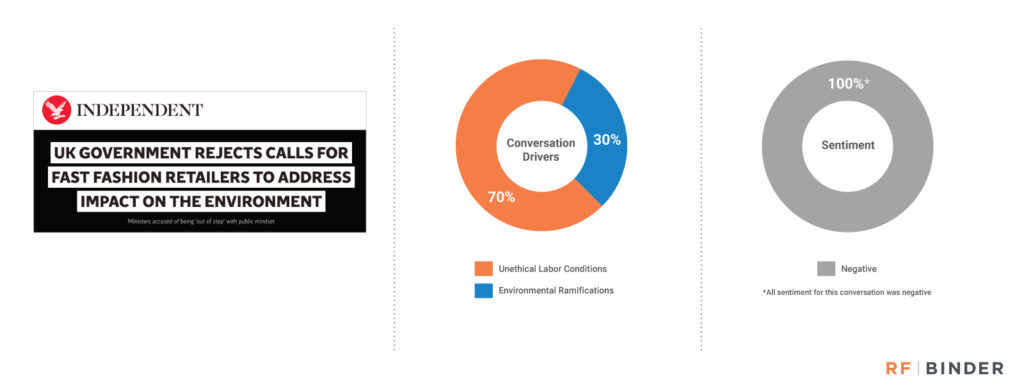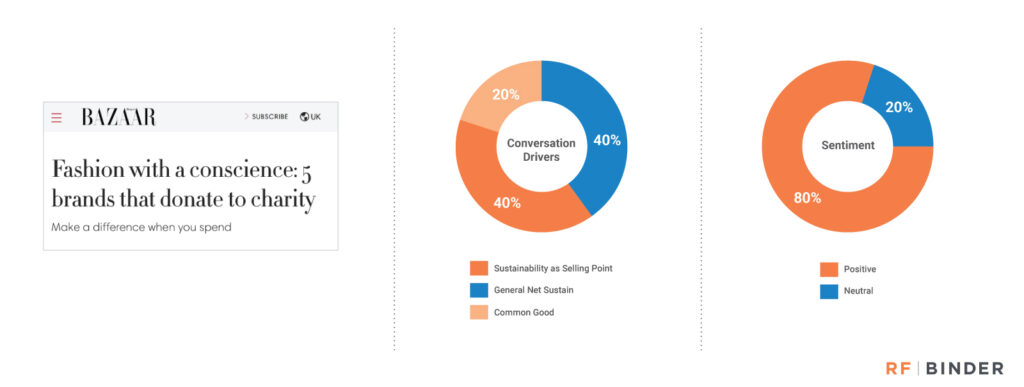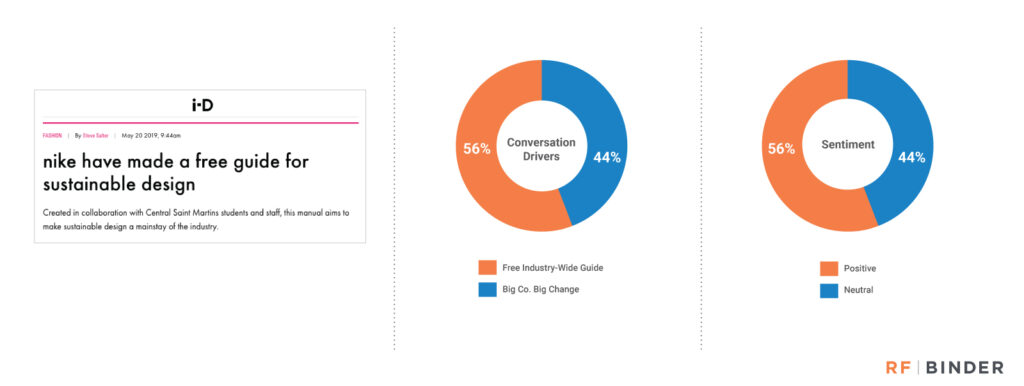The “Good Change” Report is a monthly analysis produced jointly by RF|Binder’s Social Impact & Sustainability and Integrated Planning & Analytics teams. With this report, we provide a look into which brands are driving today’s most important social and environmental conversations, and how the dialogue is taking shape. Each month, we use our proprietary tools to dig into one trending topic, pinpointing the most highly shared news stories, as well as consumer sentiment and key conversation drivers across social media platforms. Read on for this month’s hot topic: sustainable apparel.
Materially Important: Transparency in the Apparel Industry
When Yves Saint Laurent famously said, “Fashions fade, style is eternal,” he may have been a harbinger for more than just the next season. Fast fashion – essentially, clothes that are made quick and cheap in order to meet a frenetic consumer demand for, well, quick and cheap – is a multi-billion dollar industry. But staying on trend also comes at a serious cost to the environment and to the thousands of garment workers throughout the supply chain, many of whom work in unsafe and unfair conditions.
The good news is that consumers are increasingly aware of the environmental and social impacts of fashion – from CO2 emissions and textile waste to labor conditions. Issues related to sustainability have now permeated mainstream fashion conversations, and consumers are increasingly serious about understanding the origins of their clothes before purchasing. In large part due to this increased awareness and activism, the industry is poised to see some of its most significant positive shifts in recent memory. But there’s still more work to be done, particularly when it comes to helping fashion brands meet the increasingly progressive interests of their consumers.
The Sustainable Apparel Coalition (SAC) and the Apparel Impact Institute (Aii) – both of which are RF|Binder clients – present two examples of how organizations can collaborate with brands, retailers, manufacturers and fabric mills to address critical environmental and social issues. As consumers continue to demand transparency in order to make more sustainable choices, brands have an opportunity to connect with their consumers in a meaningful way. The potential to make meaningful connections is an opportunity for all apparel brands, but it’s particularly imperative for brands that aim to foster the “in me, on me, around me” mantra for sustainable living.
In this month’s Good Change Report, the Social Impact & Sustainability team at RF|Binder explores some of the most impactful recent stories in sustainable apparel. Our takeaways for the month center around the critically important theme of transparency:
- Don’t let regulation be your guide.
- If you build it (sustainably), they will come.
- The more you share, the more you care.
Read more to learn about the latest industry conversations and our insights below.
UK Government Rejection
In an apparent setback for the sustainable apparel movement, the UK government last month rebuffed the recommendations of Members of Parliament on the Environmental Audit Committee (EAC), which pushed for legislation that would force fast fashion retailers to tackle industry issues and share their impact data. As a result, the government faced backlash and criticism from industry groups and MPs serving on the EAC. Interestingly, the bulk of the social media backlash was directed not at the actions of the UK government, but at the brands that potentially stand to gain from the decision – such as H&M, Primark and Boohoo – and drew significant attention to the problematic business practices of these brands.

Net-a-Porter
Net-a-Porter, the popular online retailer for designer brands, joined the efforts of many apparel-industry counterparts to offer a new service that specifically caters to sustainably-minded consumers. The company introduced Net Sustain, a new platform that highlights sustainable brands and ethically made products, according to criteria set by Net-a-Porter. The social conversation was largely positive, highlighting the importance of sustainability as a selling point, particularly among luxury brands.

Nike
Nike championed a more sustainable apparel industry at the Copenhagen Fashion Summit, contributing to its reputation of radical standard-setting. The brand launched a free manual for sustainable design that lays out the principles of circular design, developed in partnership with students from London arts and design school Central Saint Martin. The public response was highly positive, praising Nike for its actions in providing an easily accessible resource for brands, designers and manufacturers looking to drive change.

Our Big Takeaways
If there’s one thing that these three stories have in common, it’s transparency. Simply put, transparency is essential for any brand that wants to build loyalty among millennial and Gen Z consumers. But there are numerous ways organizations can drive transparency in a way that’s meaningful and authentic for their own consumers and brand:
- For every industry in every country, there is some form of government regulation. It goes without saying that brands must adhere to all local and regional regulations, but it’s critically important that brands not let regulation be their limit or their guide. The strongest brands are collaborating and innovating in collaboration with their governments. In terms of transparency, brands should be leading the charge to push regulatory bodies to decrease GHG emissions, reduce chemical use, limit water waste and ensure safe and fair working conditions for garment workers.
- While there is currently no industry standard for measuring and comparing the sustainability of one t-shirt to the next (though the Higg Index is getting close!), we do know that if you build it sustainably, they will come. The easier it is forstakeholders to access sustainability information, the more positively those stakeholders respond. Unsurprisingly, we are seeing an increase in the curious citizen who might ask: How was this garment made? Who made it? Where was it made? By launching Net Sustain, Net-a-Porter demonstrated leadership in simply offering information and communicating transparently about its inventory.
- Providing open source information gives brands an opportunity to shape industry standards and set consumer expectations for transparency. In the case of Nike, which famously raised the industry bar nearly 15 years ago when the company disclosed its entire supply chain, releasing a global database of nearly 750 factories worldwide, the launch of a free manual reinforces its reputation. It also demonstrates that Nike understands the urgency required – by sharing relevant learnings, other brands can potentially save time and money by not repeating mistakes. Be willing to share your perspective, because, the more you share, the more you care.
For questions about our report, or to discuss how our team can help create leadership for your purpose-led brand, e-mail RF|Binder’s Social Impact & Sustainability team at sis@rfbinder.com.


